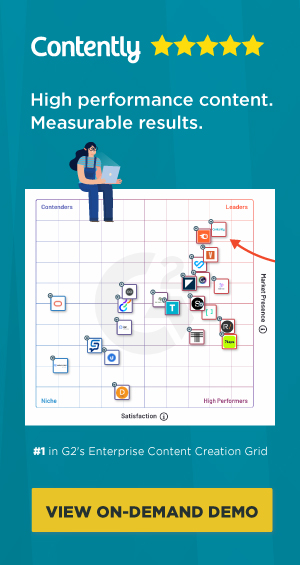Finance
How to Unlock the Potential of Content Marketing for Financial Services: Q&A with an Expert
From TikTok tutorials offering snappy investment strategies to in-depth podcasts revealing the secrets of wealth management, today’s consumers have no shortage of financial content.
However, this explosion of resources presents a mounting challenge for financial services companies that have relied on tried-and-true content marketing playbooks for years. No longer is their competition confined to traditional industry players—82% of financial services marketers actively use content marketing—but they now find themselves vying for attention in a digital space crowded with influencers, financial bloggers, and fintech startups.
So, what should content marketing for financial services look like in 2024? How can financial services companies surpass hurdles to successful content creation, like compliance, organizational silos, technological adoption, and company culture?
JB King, a veteran in the field, is no stranger to these financial content marketing questions. With over a decade’s experience in the industry—including roles as Director of Marketing and Communications at EY and Global Head of Content at Marsh & McLennan—King has had a front-row seat to how content marketing for financial services has evolved. Here are her top insights.
You’ve worked extensively in content marketing for financial services companies. What are some of the biggest hurdles you’ve faced?
A big one is when the marketing and communications department is viewed as a service bureau. It’s very common to have organizations where the client-facing and revenue-generating professionals come to internal marketing and communications staff at the 11th hour when they want materials created, often for a one-time event.
This is the point when the marketing communications person, who wants to be responsive, begins the hoop-jumping process required to deliver a reasonable facsimile of the item requested. Quality is often compromised and rush charges incur because the timeframe is simply unreasonable.
This “order-giver, order-taker” mindset creates a dynamic in which the revenue generators lose confidence in the marketing staff, who, in turn, become demoralized. It also does a tremendous disservice to the company from a brand-building and marketing perspective.
Another big hurdle is underfunding, which leads to a scattershot approach where too few dollars are spread across too many marketing initiatives.
How do you get past them?
In the case of the service bureau mentality, you start by partnering with the business execs and educating them on what the marketing and communications staff needs from them to produce the kind of high-quality materials they expect and the company deserves.
You also have to coach the marketing staff on how to function like a consultative professional service that brings value to the entire marketing and communications process. That means learning to ask questions about who the target audience is and what you want that audience to think, feel, do, or say as a result of seeing a particular piece of content. It involves understanding the touch points and stages of a sale or engagement, and where the prospect or client is within the lifecycle. It includes planning and anticipating when content needs to be developed and delivered, as well as what form it should take. It’s a much more strategic approach.
When I was running creative services at Lehman Brothers, we established a model where there was a designated relationship manager for each business unit—i.e., fixed income, equities, investment banking, etc. Their job was to get to know the business. This enabled us to begin a dialogue with our internal customers much earlier in the process, plan for periods of high demand, make informed recommendations on the most effective approach, and help them develop a yearly strategic marketing roadmap.
Helping the business players deepen their understanding of the marketing discipline is also integral in the case of underfunding. The scattershot approach tends to happen because there are multiple business lines that are all competing for a share of the limited marketing budget. Attempting to allocate the funds across all of the requests often results in so much dilution that none of the marketing activities has any real impact.
Rather than spreading the troops thinly across the entire battlefield, a more effective strategy is to take a page from Sun Tzu’s The Art of War and concentrate your forces (or resources, in this case). Developing fully integrated, multi-channeled marketing campaigns on one or two big business issues carries a much greater punch in terms of building your brand and achieving your business objectives.
In your mind, how does financial content fit into the larger content marketing mix?
For financial and professional services companies that trade on intellectual capital, content is how they distinguish themselves from competitors. Unlike a consumer products company that sells something tangible, financial and professional services companies sell ideas and help clients solve problems. Good content is the manifestation of their “product” because it shapes the client’s perception of who the smartest person in the room is. In that regard, content is hugely important.
What are your go-to methods for demonstrating the business value of content marketing for financial services?
Definitively measuring the value of marketing investments is the holy grail. When you’re selling services and talking about six-figure engagements, it’s even more challenging. There isn’t any one single thing that ultimately leads to closing a deal that was months in the making, but rather a combination of many things that starts with brand awareness.
Years ago, McGraw-Hill ran an ad picturing a curmudgeon sitting at a desk scowling. The caption read something like, “I don’t know your company and I don’t know you. So what is it you want to sell me?” In my experience, business people either intuitively accept this truth or they don’t. If you’re in marketing, it helps to work for someone who gets it.
When it comes to metrics, the C-suite wants to see monetary value—not pageviews, downloads, shares, or other engagement stats that excite marketing professionals. So if you can’t demonstrate revenue generation, one route that’s gaining traction is cost savings. The proliferation of digital, social, and mobile media has increased our ability to reach desired audiences with less waste and greater accuracy for a fraction of the cost of traditional media. Try shifting some funds from traditional channels into content marketing. Run a test pilot or two, then see what kind of business case you can make.
You’ve worked with a lot of CMOs and CEOs to find innovative solutions to marketing problems. What are some of the biggest challenges you hear?
Increasing speed to market. Differentiating a brand from competitors that offer parity products or services. Achieving more with less. In addition to these age-old challenges, CMOs and CEOs have the added challenges of keeping their brands relevant, moving from the web to mobile, and figuring out how to advantageously use social media—while the attention span of audiences is shrinking.
It can seem overwhelming at times because of the rapid pace of change and the proliferation of new tools and technologies, but the fundamentals of marketing, including the need to create an emotional connection with the customer, remain the same.
What’s the biggest mistake people make when it comes to content marketing for financial services?
Not milking an asset for all it’s worth. Lots of companies develop original content by investing in a proprietary study or partnering with a think tank, launch it via a press release and maybe a client mailing, and then move on to the next thing. In doing so, they’re not reaping the full benefit.
What do you want to see the industry do more of in 2024?
Less is the operative word. Less content creation and fewer acts of random content. Various sources estimate that between 60 and 80 percent of content created today never reaches its intended audience. It’s not more content that’s needed but more skillful and sustained distribution of content the end users find valuable.
JB King is a strategic marketing and communications leader focused on targeted, innovative content marketing programs that engage high-level audiences through digital channels. King can be reached via email or X (formerly Twitter).
Ask The Content Strategist: FAQs
Q: What role does content play in distinguishing financial and professional services companies from their competitors?
Branded content is intellectual capital for companies, shaping clients’ perceptions of their expertise and setting them apart from competitors by increasing their thought leadership and share of voice in the market.
Q: What is a common mistake made in content marketing for financial services, and how can it be avoided?
Companies often fail to fully utilize their original content by effectively using cross-channel promotion to create value at specific points across the customer journey to ultimately reach the intended audience effectively.
Get better at your job right now.
Read our monthly newsletter to master content marketing. It’s made for marketers, creators, and everyone in between.




